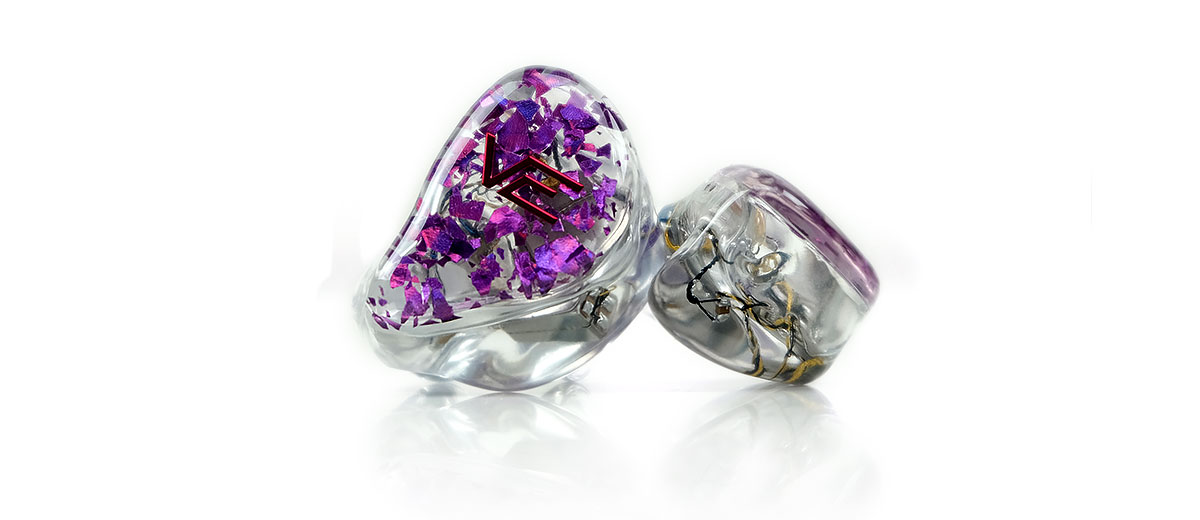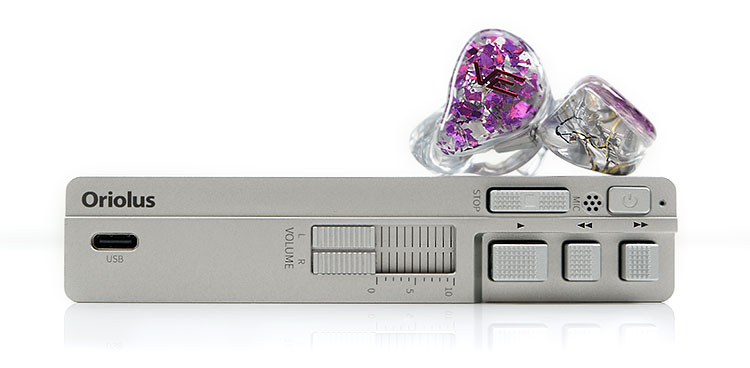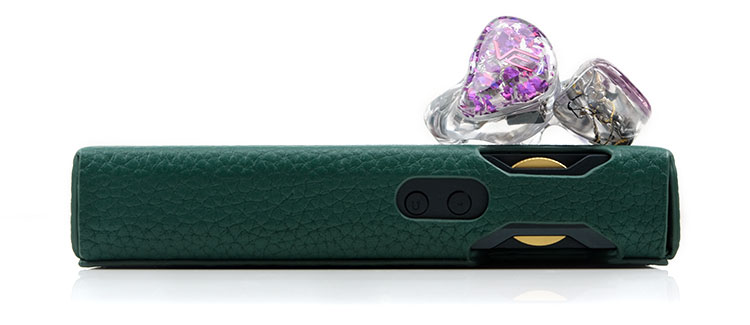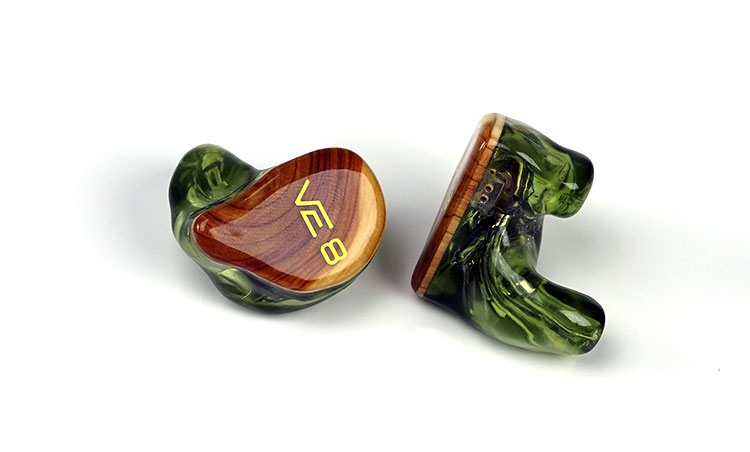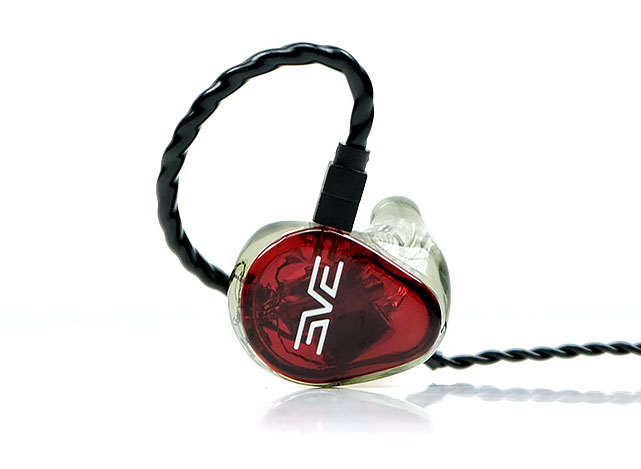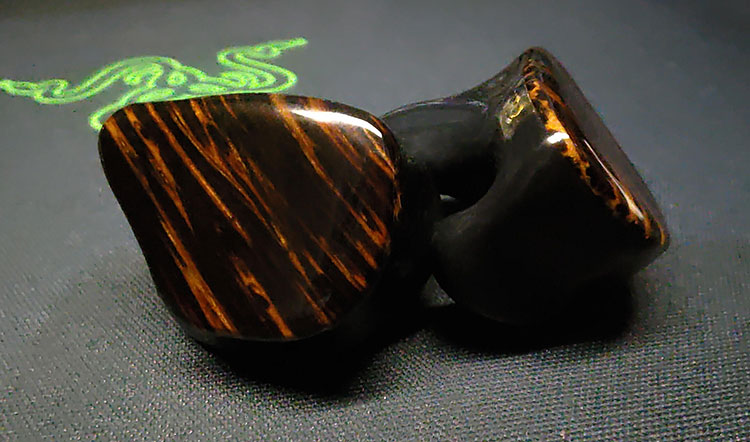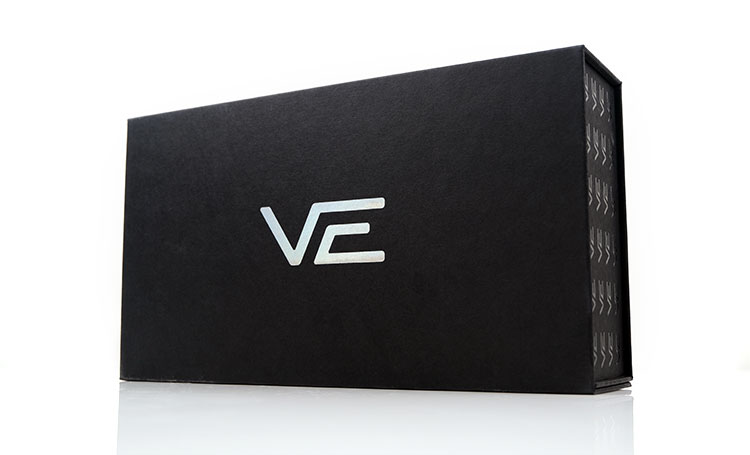Sound Impressions
Summary
With new drivers not only do you get a relatively new style of overall tuning from Amin, Marcel, and Oliver, but also a different type of sound, particularly from the VE7 top-end.
There are other aspects to discuss with the VE7’s relatively balanced response curve but the most immediate takeaway is the performance of the new mids and tweeter drivers which deliver perhaps the purest treble tone I have heard yet from a VE monitor outside of the Elysium.
Traditionally, boosted BA drivers have a dryish hard tone when overly pushed and can often create unnecessary harmonic dissonance in midrange timbre, particularly with percussion and vocals. A slightly unpleasing sound, especially with cheaper BA drivers.
With the VE7 treble tuning, you get a boost from 7-10k but it is not overly pumped up. In turn, this is ably supported by that tweeter which does a nice job injecting some headroom into the performance post-10k.
As a result, it has an airy, clean-sounding tone but neither harsh, dry, or overly hot sounding. You get more of a pure shimmery sound down into the mids and less dissonance making it a very pleasing listening experience.
Frequency Response
For the overall FR, it is quite balanced but surprisingly harder hitting on the low-end than I was expecting. There is an overall bass to mids bias in the presentation but it is very nicely countered by that clean treble tone.
The VE7 bass is at its strongest sub-100Hz with excellent dynamic range and clarity though not as planted as the more dominating VE8 low-end. There is also a slow but linear drop into the lower mids but it is not that scooped out so mid-bass warmth creeps up as well as some good instrumental presence.
Vocals are forward and clean with a smooth bump from 1-4k and just a minor dip from 5-7k where the tone has a very slight ethereal quality rather than in your face. Beyond that, the VE7 delivers that excellent 7-10k peak and better 10-14k energy compared to the VE8, EVE20, and the VE6 X1.
Timbre
There is a mix of coloration in the VE7 timbre. On the low-end, the sub-bass is tastefully elevated rather than overpowering replete with a slow drop through the mid-bass into the lower mids. It holds its elevation quite far into the mids with the low point around 1k so there is a fullness to the VE7 tone up to 1k.
The fundamental is neutral in quantity and not as heavy as the VE8 or VE4 but in return, you get some excellent layering and definition so low-end events such as kick drum thuds are very refined and clear sounding.
Instruments up to 1k do not sound thin or lacking in presence with a degree of warmth from that slow drop so not a completely neutral sound. Rather, it is not exaggerated allowing the mids to breathe and keeping everything free from muddiness.
The treble does have a pointed influence on the VE7 timbre and outside of the Elysium, it is their cleanest and purest sounding yet. Higher pitching timbre is slightly ethereal in quality but not brittle either, almost electrostatic in quality and articulation.
In turn, the mids get a mix of both that low-end warmth and rounded tone and the brilliance of the treble sound with instrumental and vocal notes sounding sweet, airy, and light towards the upper mids and smooth and natural lower down with more body.
Staging & Dynamics
Love the staging performance on the VE7, it is much more open than I thought it would be though with an ever-so-slight bias towards the extreme ends of the response curve. This is balanced out with a smooth 1-4k elevated curve to give the vocals a bit of a lift.
Depth is surprisingly good for a dual BA setup and though not as powerful as the VE8’s planted tuning its dynamic range and clarity is very good right down to 30-50Hz. The headroom from the last two mid-high and super tweeter drivers inject plenty of air into the performance creating a very wide and nicely separated instrumental presentation.
Compared to both the VE8 and VE6 X1, the VE7 sounds the more open of the three in the midrange with a vibrant and slightly forward vocal presence over that 1-4k rise. The clean treble also helps give spatial cues a little more presence so it is quite easy to pick up small instrumental interplays and higher-pitched percussion strikes.
I do suggest you grab a more resolving balanced cable to stretch the imaging and dynamic range of the VE7. The stock cable is a little more compressed for me and not as resolving sounding compared to the EA Ares II 4-wire balanced cable I have available here.
Synergy
Efficiency
The VE7 is rated at 12Ω and 116dB SPL which is fairly consistent with the majority of the VE Line from Vision ears in terms of sensitivity. However, we did note that the older models might just need 1-2dB less volume compared to the VE7, models such as the VE8, EVE20, and the VE6 X1 for example.
That being said, the VE7 never really requires much juice to sound optimal so weaker sources and good quality dongles should be able to power them reasonably well. The rest will come down to your sources resolving capability and timbral preferences.
If you do plan to retain the stock cable and go SE with DAPs the VE7 is an excellent performer for noise. I tested 5 DAPs, including higher noise performing ones such as the HiBy R8 and the FiiO M15 and both were very silent. With the likes of the Lotoo PAW Gold Touch, DX300, and the Sony 1Z the background was nice and black.
Balanced did much better than I expected using a 4-wire EA Ares II cable with only the HiBy R8 4.4mm output creating any sort of meaning full hiss. The other DAPs, including the M15, were actually quite quiet.
Pairings
I much preferred a more emotive source sound signature with the VE7 over neutral or clinical alternatives. Particularly if they added a bit more physicality to the snap and obviously excellent dynamic range of that dual low-end driver.
Sources such as Sony’s flagship 1Z and the LP P6 Pro offered the most substantial reward on the VE7 bass performance with the 1Z offering the strongest sub-bass response and the P6 Pro offers the best texture and detail with a stronger more natural vocal performance over the Sony.
Both were very smooth on the top-end and mids without any loss of detail or air, particularly if you change to their balanced outputs with a cable such as the Ares II. Neither were quite as expansive as the DX300 in terms of staging and with its analog tone and excellent articulation, it’s a really nice pairing. Just not quite as textured as the P6 Pro for vocals and bass.
I felt the M15 was also quite good in terms of bass layer and dynamic range with the VE7 but the mids and treble were a bit too neutral for me leaving the VE7 perhaps too lean and lacking in character to truly enjoy.
The HiBy R8 is probably the better of these two Android players with its additional low-end weight and warmth injecting a bit more natural flair in the VE7’s midrange tone. The Lotoo PAW Gold Touch was more solid in the mids and treble than the M15 but it also felt, well, a touch too reference for me.
Select Comparisons
Vision Ears VE8
€2350
The flagship of the VE Line and second only to the Elysium. Reviewed in mid-2017, the VE8 is an enduring model and is still very popular today. It is also more expensive than the VE7.
Technical
The configuration is not surprising given the VE Line nomenclature with an 8-driver all-BA design with a dual driver for the lows, another dual driver for the mids, and 4 super tweeters for the treble (2 x dual). All of this is threaded with a passive acoustic 3-way system.
The VE7 is also an all-BA but with 7 instead of 8 logically as well as taking advantage of new dual drivers from Sonion and Knowles to improve the low pass and high-end frequency response. The crossover is also a little more complex now with a 5-way passive/electric as opposed to 3-way.
Both are fairly sensitive monitors with the VE8 rated at 22Ω and 120dB and the VE7 with a slightly lower impedance of 12Ω but marginally less sensitive at 116dB SPL.
Neither are going to need huge voltage or current to be easily driven so weaker sources are fine. Just watch for higher noise floors such as going balanced from the HiBy R8 as both can pick up a bit of hiss quicker.
Design
Both of these samples are custom designs with each showcasing different aspects of VE’s product portfolio. Aside from the different design choices, the only difference is the Translucent Purple plate of the VE7 is part of the new collection but you can also pick this design for any new VE8 as well so it’s not exclusive.
One visual difference is the form factor with the VE8 slightly smaller on the plate compared to the VE7 though this might just be a change in the company’s build methodology since the VE8 uses an additional driver.
This particular VE8 sample uses a heartwood plate with a translucent green shell which complements each other quite nicely. Not quite as translucent as the VE7 design but some might prefer the warmer organic tones and denser color scheme.
Because both are all BA there is no venting port so the pressure, seal, and resulting isolation are among the best in the business for me. The two monitors also make sure of a 2-pin 0.78mm connector system and come with a basic 4-wire OFC cable which I recommend changing to something with less resistance if you want to release their true performances.
Performance
The Vision Ear VE8 is the power choice of the two but the gap is not as big as you think. I actually think the dynamic range and definition on the VE7 is closer to the VE8 than I was expecting and both hit nice and hard.
The key differences are more in terms of how much warmth the VE8 sustains into the mids which is greater and how its L-shaped response doesn’t quite have the same pristine treble quality compared to the VE7. This allows the VE8 to fill up the lower mids a bit more with instruments delivering a heavier bass fundamental.
That also changes the timbre and perhaps the perception that the VE7 is lighter on the bass but really it’s the stronger bloom from the VE8 into the lower mids that creates the perception of enhanced bass quantity more than just sub-bass amplitude.
The VE7 does have that 1-2k mids lift as well as the stronger cleaner treble so there is a much greater push in the presence region. It’s airier sounding, a bit lighter in instrumental body, and sweeter in tone with more of a shimmer into the upper mids.
The VE8 is more rounded in its instrumental timbre, a little more weight on the fundamental also or more of a bias in that area, and comparatively less air and sparkle. Instrumental separation is stronger on the VE7, and vocals, as well as upper-mids percussion, have that little odd-harmonic lift and are not as thick.
No question the VE7 treble extends better and sounds the more articulate of the two with a stronger vocal presence. However, if you want the edge in power and physicality the VE8 is probably the go-to choice here.
Vision Ears EVE20
The EVE20 was launched last year, hence the name and to date is the only official universal form factor-only monitor launched by Vision Ears. You can find our review of that here.
€1300
Technical
The EVE20, like all of Vision Ear’s creations, is an all-BA creation but this time it uses 6 balanced armature drivers with a dual-vented sub, a dual full-range driver, and a dual mid/high BA driver. The precise grouping of the drivers is 2 for the lows, 2 for the mids, and 2 for the highs with a 3-way crossover.
The VE7 splits the mids into a dual driver for the low-mids and mids and a dual for the mid-highs and highs. It then adds a super tweeter for the ultra highs. All of VE7’s drivers are new vented drivers from Sonion and Knowles using a 5-way passive acoustic/electric crossover.
Both monitors are easy to drive and fairly sensitive with the EVE20 rated at 25Ω and 120.5dB SPL and the VE7 with a lower resistance of 12Ω and slightly less sensitive at 116dB SPL. As with the VE8, neither are going to tax your DAPs current or voltage output but due care should be applied to balanced outputs such as the HiBy R8 if you are sensitive to hiss.
Design
Because it is a universal monitor there are some design differences. For example, the form factor is a lot smaller, and whilst it has some nice custom contouring to its shape it is designed to place more emphasis on using ear tips to create the final seal in the ear canal.
That does mean a flatter underside to allow the monitor shell to get that bit closer to the concha basin and help create a more effective seal. Both have no venting ports so the level of isolation is enhanced compared to hybrids or metal designs.
In that regard, the EVE20 does very well indeed but it is not on par with the VE7 for dB isolation levels. The precise custom fit makes a difference here.
The other key difference is the visual color mix which is fixed on the EVE20 and is a mix of the VE8 sample we discussed earlier in terms of that olive translucent shell and an attractive ruby red faceplate with the EVE and VE logos on top. With the VE7 custom, you can have pretty much any design VE offers.
Both use a 2-pin connector system and both offer the pro-orientated but rather basic high resistance 4-wire OFC cables with the EVE20 version in black and the VE7 sample we have here in a silver finish. You can order the black version that comes with the EVE20 if you prefer.
Performance
With the EVE20 you can tell Vision Ears were already trying to fine-tune the treble performance to a higher level before they launched the VE7.
The EVE20 top-end is a bit like the best of the older driver with the VE7 the new driver ‘kid on the block’. You can hear the difference right away with the VE7 top-end sounding more exquisite and refined with a very pure tone whereas the EVE20 top-end offering a slightly harder traditional BA edge to high pitched notes.
There is also some energy also beyond 10k in the VE7 tuning that the EVE20 lacks so air is more generous on the VE7 even though the EVE20 might actually be more amplified around 8k.
Both have above-average weight on the low-end for a BA monitor but the VE7 offers more weight and warmth and sounds the more planted of the two monitors for power. It is not as dipped either in the lower-mids so instruments have more presence and a bit more richness to their lower order harmonics.
The midrange timbre on both is relatively sweet-sounding with a mix of low-end warmth and treble presence influencing both vocals and instruments. However, the VE7 additional power and warmth and that more sustained mid-range bump 1-4k give the VE7 a bit more of a natural hue and better presence to vocals.
The EVE20 has more of a light touch about its midrange timbre, though relatively airy and with good separation also. The 1-4k range is not quite as linear in its tuning with the lower mids dipping a bit more which tends to reduce that body and warmth in its vocals compared to the VE7.
Vision Ears VE6 X1
€1550
We reviewed the VE6 as the XControl version way back in 2014 but since then the sample here has been converted to the X1. You can get either or the X2 version in a custom format depending on your preference.
Technical
No surprised with its all-BA configuration consisting of a 4-way passive acoustic system with a grouping of 2 for the lows, 2 for the mids, 1 for the mid-highs, and a super tweeter for the highs.
With the additional vented driver inside the VE7 and a 5-way system, the big difference in the configuration is the stronger focus on the highs thus allowing the tweeter to push higher up for the ultra highs.
Now, I am pretty sure the drivers used in this VE6 sample are much older versions of the new vented dual drivers used inside the VE7 but it is possible VE has also updated them since I reviewed the VE6 back in 2014.
As with all VE ratings the VE6 is fairly sensitive at 20Ω and 112dB SPL compared to the VE7’s 12Ω and 116dB SPL so it will not take much to drive either of these monitors.
Design
This VE6 in the smart cam picture above is actually the second design for this VE6 model I have had done. The previous VE6 XControl was a plainer dark wood grain on the black shell but when switching to the VE6 X1 VE asked to use a newer Zebrawood grain and it did have a bit more pop about it.
Personally, these days I prefer a more translucent design to the matte or solid color alternatives but black worked quite well in this instance with the zebrawood grain integrating quite nicely.
Because it’s an all BA with no vent porting and based on the same ear scans the fit and seal is as good as the VE7. Consistency is key here so the same company, the same scan should result in the same outcome year after year, (so long as your ears do not change shape).
One thing to note is the difference in the horn designs between the VE7 and VE6 X1. The VE7 uses a kind of exponential shape that goes from a round section to a triangular mouth whereas the VE6 X1 uses VE’s traditional stepped horn.
Both the VE6 X1 and the VE7 use 0.78mm 2-pin connection systems and yes, both use the simpler 4-wire OFC pro-orientated cable in either black or silver.
Performance
You can clearly pick out the step-up both in terms of an additional driver focused on the highs and the upgrade to the vented drivers from the older non-vented ones.
The VE7 sounds a lot airier, more pristine, and extended on the top end whereas the VE6 sounds a little closed in, more rounded, and less distinct on the treble. When it does focus on the treble it has that older “BA’ dry tone and is not quite as sweet and articulate in its delivery compared to the VE7.
The VE6 X1 can sound a bit more weighted on the low-end, and certainly, its curve is a bit more u-shaped compared to the gentler W-shape of the VE7 so if you do need a bit more of a low-end lift then the VE6 X1 will give it but neither are as colored in that low-end as something like the VE4. If you need bass from a VE Line monitor then get the VE4.
The dip in the lower mids to around 1-2k is also quite pronounced on the VE6 X1 whereas you get more of a lift and a traditional 1-2k bump on the VE7. The VE6 X1 is lacking a little air around that area and doesn’t have quite the presence and openness of the VE7’s midrange performance.
Vocals around 2-3k on the VE6 X1 do a lot better and that’s where it’s at its strongest with higher-pitched soprano vocals. However, you can still detect the difference in the timbre with the VE7 offering a little more sweetness and an odd-harmonic lift pulled from that extended 8-10k treble sparkle.
Our Verdict
When you consistently get everything peripheral nailed then it’s really easy to devote your sole attention to the tuning of any monitor. Such is the case with the VE7 with Vision Ear’s ever-present excellent design and build quality that makes their customs a pure delight to wear for hours.
That allows Oliver and the VE team to weave their magic and integrate those entirely new drivers with a degree of artistic license from a very stable platform. The resulting VE7 performance is thus less ‘bish bash’ or hurried sounding and more nuanced with a very refined treble and just enough warmth and body on the low-end to create a very pleasing contrast.
Overall, the VE7 sound is what I would call a mature and confident high-end audiophile tuning where the subtlety and detail matter much more than just “phat bass” and shouty vocals.
Vision Ears VE7 Specifications
- Five-Way-System with seven drivers
- Driver Configuration: 2 x Bass – 2 x Low-Mids – 1 x Mids – 1 x Mid-High – 1 x Superhigh
- Sensitivity: 116dB SPL at 1 mW
- Impedance:12 Ohm ( at 1 kHz

